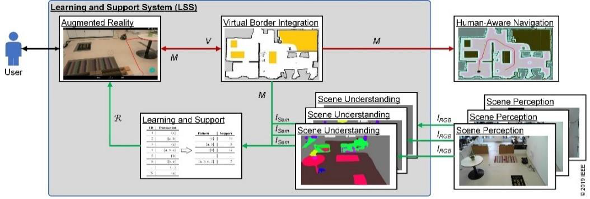Internationale Partnersuche
Innovation & Technologie Angebot
Learning and support system for mobile robots to detect virtual boundaries
Country of Origin: Germany
Reference Number: TODE20200814001
Publication Date: 18 August 2020
Summary
A German university developed a system that improves the learning of mobile home and industrial robots with regard to their working area. This in turn simplifies the adjustment of the robots for the user. The university offers a license and/or a technical cooperation agreement.
Description
Users of mobile robot systems often want to restrict the working area of their mobile robot, such as vacuum cleaner robots or intelligent helpers with gripper arms. This is for example done to exclude sensitive areas, such as bathrooms or bedrooms in appartments or to exclude spots that can lead to navigation errors, such as carpets. In industrial environments it may be a manufacturing area or a hazardous zone that needs to be excluded from the robot’s working area.
Current solutions are based on pure interaction between humans and robots, during which a user explicitly defines these restriction areas, for example by pointing out the boundaries of the area. The more areas that need to be defined and the larger they are, the more time it takes. This is not user-friendly. But what if the system already knew which areas a user would like to exclude? This is the basis for a new process that significantly reduces the interaction time between humans and robots: By linking intelligent environment detection, self-learning behavior, and augmented reality.
A German university now developed a robot system that learns from previous user interactions with the help of cameras and the semantic evaluation of the image content, called semantic segmentation. This makes it possible for the system to suggest “virtual” boundaries to the user, which are then displayed by means of an “extended reality unit”. Such virtual boundaries are non-physical boundaries that the robot does not cross and which reliably limit its working area. Augmented reality thus assists the user by suggesting virtual boundaries, significantly reducing the interaction time. This should considerably increase the user-friendliness of this kind of system when restricting the working area of a mobile robot.
The university offers this invention to manufactures and developers of mobile robot systems interested in implementing the technology in their systems within license agreements.. They also offer interested companies the possibility to further develop the technology to market-readiness.

Advantages and Innovations
This invention improves the self-learning of cleaning robots that is currently in place. It allows a fast setup and an autonomous operation, which is not possible today. In addition to that it is cost-effective.
Stage Of Development
Under development/lab tested
Stage Of Development Comment
Fundamental proof of function is provided and further prototype development is planned.
Requested partner
The invention is aimed at manufacturers and developers of mobile robot systems, including transport robots, which can be used in smart home environments or in companies.
The university offers a license agreement to companies interested in integrating the technology into their robots. If technological support is required for further development to market maturity or for system integration, the university also offers a technical cooperation agreement.
Cooperation offer ist closed for requests

